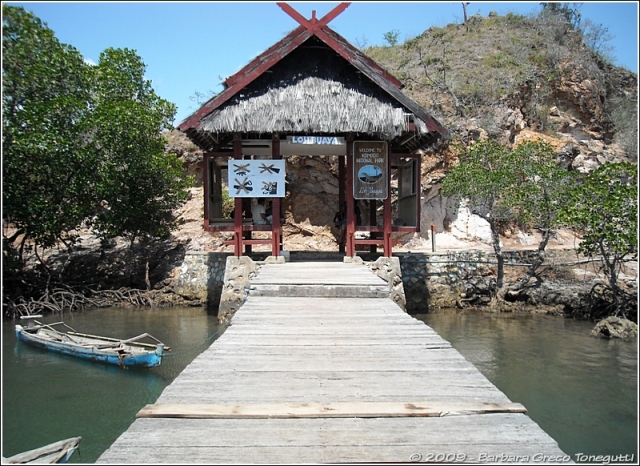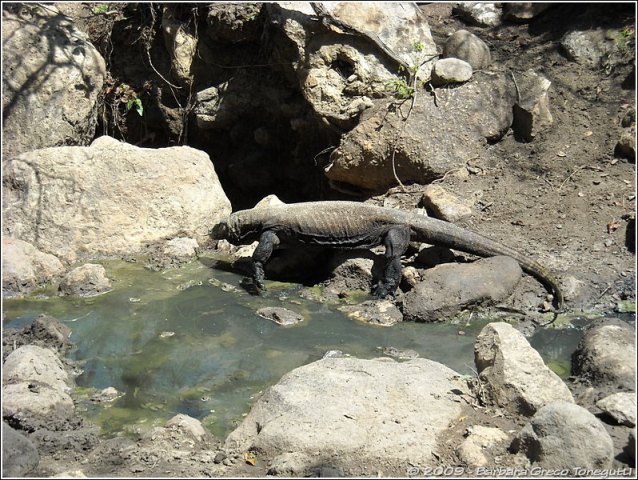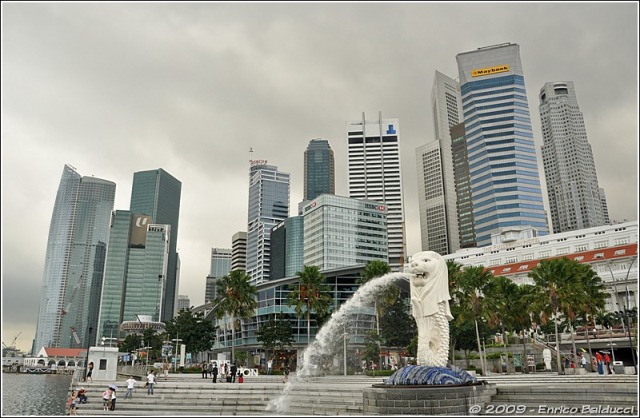|

| |

(our route from Darwin to Indonesia and
Singapore)
The title of this page is quite an understatement, in
reality Bali and Singapore were the Rally's "official" stopovers, but the actual
itinerary planned entry into Indonesia in Kupang, on west-Timor, to then reach
Bali by leisurely sailing along the "Spice Islands", visiting the Komodo
National Park, Sumbawa and Lombok along the way.
After leaving Bali, many boats opted for a
stop in Borneo to visit the Orang-Utan reserve and from there head towards Batam
island and the Nongsa Point Marina were we would officially exit Indonesia.
Few miles, but across one of the busiest
seaways in the World, would then bring us to Singapore.
Just few days before our departure from
Australia, the nasty surprise: Indonesia had just changed the rules concerning
visiting yachts, and the 100-odd yachts of the Sail Indonesia Rally have been
impounded in Kupang, expecting them to pay a hefty import-tax! The
BWR management made their best to find a solution, but then the only available
alternatives we were offered were:
1) go straight to Bali, where apparently the
new rules were not yet enforced
2) pay nearly 1000 US$ to be "invited" by a
local Yacht Club which would "guarantee" for us, therefore exempting us from the
import duty.
Like most other crews, we had to shut up and pay, despite we had just incurred in several expenses, like a new
outboard motor, which had left us rather strapped for cash.
14/10/2008
RUPIAS AND DRAGONS...
After a 500-mile passage mostly done under engine, we reached Kupang on the
island of Timor, our port of entry into Indonesia.
"Port" is not the more appropriate word though: we anchored in front of the town,
along a straight shoreline which is giving little shelter from the swell.

The rather exposed anchorage in front of Kupang,
West-Timor
After having performed all formalities, which were more expensive and convoluted
than actually lengthy, the next challenge was to find an ATM to get a few
million Rupias: yes, the Rupia has a very low value, and its gets some time to
get accustomed to the fact that 10000 Rupias are just less than one Euro and
when they ask for 100000 Rupias for a pearl necklace that's actually less than 10
Euros...


(left) the rather chaotic market in Kupang
(right) young boys offer their services to carry the purchased goods
The town is lively and interesting, and the people very friendly although
language is a problem, english is seldom spoken and often very poor; a bit
annoying the insisting vendors of all sorts of trinkets, but the saddest thing
is the rubbish everywhere, even though people is properly dressed and shops are
reasonably clean.
After having left Kupang without many regrets, we reached the Komodo Nationa
Park, anchoring for the first night on the south coast of Rinca island: there
are the famous Komodo "dragons" walking along the beach!! It's rather impressive,
it looks like we are in Jurassic Park.

Yachts anchored in the cove on the south side
of Rinca

From the dinghy we follow a big Komodo dragon
walking along the beach
(In fact we may have been a bit careless!
Only a long time after, Baby confessed that she was not aware the dragons were
carnivorous and potentially aggressive!)
The following day we circled the island to reach the Ranger station from where
we took a long and torrid walk around the island's interior: stunning scenery,
dragons aplenty but also monkeys, water buffalos, deer, wild horses, the lot.

The Park entry gate at the northern shores of
Rinca island


One would expect a T-Rex to show-up any time...

The largest dragons are easily 3 meters long and despite their apparent lazyness
they are capable of sudden sprints and are frankly quite dangerous animals,
although the last time they killed a tourist has been more than 20 years ago...
(anyway, our guides were watchful, without making themselves too obvious, ready
to kick any too-curious dragon on his nose with their long sticks...).
We go back on board totally exhausted, but it was worth it!!
17/10/2008
VOLCANOES AND SMILES!
Two things of which there is no shortage in Indonesia: not only the islands are
obviously of volcanic origin, but there are several active ones as well:
yesterday we anchored at the foot of one, a 3000-meter high mountain, just in
front of a tiny fishermen's village.
We went ashore with the dinghy, zigzagging around fishing boats of all shapes,
and once on the beach we were surrounded by all the village's kids, discreetly
watched by the adults from a distance.
Our attempts at communication did not go far, as nobody speaks a word of each
other's language, but soon we found a game that fascinated the kids: photos!!
They love being photographed, and they laugh like crazy when they see themselves
on the cameras' screen!

Baby and Phyllis of "Gaia" are surrounded by
the village kids


The village is very modest, but the kids are
spotless and dressed impeccably
As soon as you point your camera towards one of them, they rush to form a group,
all smiling from ear to ear; they all follow us along the only road that, after
about a kilometre, leads to a somewhat larger and better-kept village.
The houses are all built on stilts and are very different one from the other:
some have features obviously copied from western-style houses, others are
all-wooden and garishly painted, others are completely ceramic-tiled.
There is also some "shop" selling soft-drinks, rice, mysterious
brightly-coloured bags and not much more.
Back to the boats, three of the more adventurous kids find a small canoe and
come to greet us, gaining some cookies as a reward. Smiles abound!
GILI AIR AND LOMBOK...
Before reaching Bali, we stop for a couple of
days in Gili Air, a diminutive island in front of Lombok, which is claimed to be
"like Bali 30 years ago".
Gili Air is pleasant, filled with small, simple resorts where we can have dinner
on the beachfront without getting bankrupt.


After a quick passage on a local
outrigger-boat, we jump on the mini-buses that will take us around Lombok; some
spectacular sceneries will be our reward.



27/10/2008
BARONGS AND UMBRELLAS...
Bali cannot be described in few words: this time we are not in front of a simple,
primitive culture, but rather of a very complex, ancient society, whose culture
is the result of continuous contact with nearby civilizations, especially India
but also China, from where the Balinese people apparently came in the first
place.
Very different, Bali, also from nearby islands: the people's relationship with religion,
a form of hinduism mixed with ancient traditions, is continuous. There are
temples everywhere, complemented by temporary ones marked by pieces of cloth (orange
and white, or black and white, to represent the fight between good and evil) or
small umbrellas. We see umbrellas even in the sea, probably to bless the nearby
nets.
And you do not see all days a temple inside an ATM cubicle!...

The first of a long series of temples that we
visited on Bali


Many temples require people to wear proper
attire to visit; impure people, including pregnant women and fools are not allowed!
The concept of holy trinity, initially intended as three different
manifestations of the same god Shiva and then evolved in the Trimurti (Brahma,
Shiva and Vishnu) and the concept of the 5 components of everything (fire, water,
clay, air and spirit) as well as the 3 component of the human being (body,
thought and soul) are ever-present and continually referred-to in the temples'
architecture.
Intriguing also the concept of the tower with an empty throne (for the god) at
its top!...
Even the salutation gesture, with the hands clasped together, symbolizes the
opposition between good and evil, as well as the temples' doors.
It's interesting to note that in many of the ritual dances, full of rigidly
defined characters and gestures, the conflict between good and evil does not end
with a clear victory of one over the other, but rather in a stalemate until the
next fight.

Among the characters, the Barong, a sort of horse/dragon with a tiger's head,
quite probably of chinese origin, is the god of good, despite being quite ugly!
Also the statues of the door guardians, to be seen in front of every temple door,
are meant to terrorize the evil spirits with their looks.


(left) the Barong, a friendly spirit, despite
its appearance
(right) a guardian-spirit at the entrance to a temple
Pity that tourism has spoiled a little the people's behaviour, although they
remain in general very friendly and smiling (and Beautifull as well: it's very
infrequent to see ugly or fat people, and especially kids and young girls are
generally quite Beautifull!).
28/10/2008
LITERARY REFERENCES...
Borneo, the land of many of Joseph Conrad's books, most notably "Lord Jim".
I do not know what to expect exactly, but we are heading towards a little town
on the border of a river which we will have to sail on a local boat to go to the
National Park where they retrain orang-utans to re-introduce them in the wild:
seems interesting!
03/11/2008
BORNEO!...
The adventure begins! We board a "klotok", a narrow motor-launch about 10-meters
long, covered by a long cabin on top of which we install ourselves, under a
canopy which protects from the sun as well as from the frequent rain.

The small town of Kumai, southern Kalimantan
(Borneo)


(left) Baby on the roof of our "klotok"
(right) long hours along the river to reach the orang-utan's natural reserve

A "klotok" like ours, this one rented by Mike
and Lorraine of "Big Blue"
There are 4 people on board: the captain, a boat-boy, a female cook and Kasri,
our guide; a fifth person took station on board Shaula to guard it while we will
be away.
We motor upriver, occasionally meeting a motor-launch or a decrepit power-boat,
there are villages along the river even if we will only see a few roofs here and
there, and occasionally we see small canoes hidden in the bush at the side of
the river, with somebody quietly fishing. Gradually the river gets narrower
until it's only a few meters wide, and every now and then our guide points at a
monkey or even an orang-utan sitting among the trees. Not many birds, but the
few we see are very brightly coloured.
We reach Camp Leakey, a research-centre where orang-utans are trained to become
self-sufficient again and then reintroduced in the wilderness: they are huge
beasts, very strong and, despite their rather dumb appearance they can use tools
and will soon show us that they are smarter than their looks would suggest.
Our guide, who has been a Park Ranger for several years, gives a bottle of water
to a female, and she UNSCREWS THE CAP and drinks! I the meantime, her baby hangs
from her back using his hind arms and pulling faces!
Later, the same female sort-of attacked me, grabbing my legs and sending me to
the ground; I was a bit worried because she had just been described as a
temperamental animal which has bitten several people for no apparent reason, but
in the end nothing happened.


Funny, looking at the orang-utans moving from tree to tree: they lean out on a
branch, causing the tree to bend, until they can reach for a branch from a
nearby tree: they pull the branch until the new tree is near enough and then
they move over!
Easy to see when an orang-utan is approaching: you see the trees shaking!
On the way back, under torrential rain, we find the only shelter occupied by a
big male with a "try to shoo me away if you dare" kind of face, and so we amass
ourselves under a nearby roof; the male then stages a "king kong" act, reacting
at an approaching female with big roars and then throwing around the big benches
on which he was previously sitting while he was hanging from the shelter's roof.
A Ranger has to threaten him with a slingshot (empty, in fact...) and he goes
sheepishly away. In the meantime another female who was under the same shelter
goes away and catches a plastic bag to cover her head from the rain...
At night, we anchor along a bend in the river: just under us, a crocodile is
waiting his prey, while we have our own trouble at protecting from the big and
aggressive mosquitoes...
Later, at another park station, we see an orang-utan running out of the Ranger's
house, where he had stolen a bunch of bananas and another big fruit: he climbs
over a tree, and puts the whole banana bunch in his mouth...
The Ranger tries to complain loudly, but he does not care...
We return aboard Shaula soaking wet due to another rainstorm, but it was really
worth it!
04/11/2008
TROPICAL WEATHER...
When we reached Indonesia, we were met by the typical tropical weather: damp,
hot and with frequent, short rainstorms.
Now we are near Borneo, and to make things worse we are in the transition period
before the wet season, and the situation has worsened: last night we had a long,
continuous rainstorm which left us soaking wet and very tired, because the
wind-against-tide situation caused a short chop that was making us bang
uncomfortably into the waves.
Now we have 2 knots of wind (!...) and all around us the clouds are preparing
for the next shower...
Alas, we will have to live with this kind of weather for a few more weeks!
The 600-odd miles from Borneo to Batam island
were characterised by light winds and a strong contrary current, so we were
worried of possibly having to detour to an intermediate port for refuelling.
Also "stargazer", which we hear over the radio, has the same concerns, but in
the end the current slackens a bit and we manage to reach Nongsa Point running
on fumes. The marina is new and still empty, so we go straight to
the fuel station, before going to our well-earned mooring place.
The place is not bad, but prices are much higher than in the rest of Indonesia,
apparently aligned with nearby Singapore.
23/11/2008
MERLION!...
That is, MERmaid-LION: it's Singapore's symbol, an odd siren with a lion's head (Singa
in fact means Lion, an animal that apparently was quite common in the area in
the old days)
.
Singapore: a heart-stopping experience to arrive here, crossing one of the busiest sea-lanes
of the world and then one of the largest commercial ports in the planet, to
arrive to a disappointing marina with dirty water and a heavy swell due to the
nearby traffic of pilot boats.
The town instead, is nice: modern, of course (the settlement dates back only to
1819) but airy and with many spectacular views, and full of literally HUNDREDS
of shopping-malls, where one can find everything at competitive prices (after a
lot of bargaining!!...).



The town can be rightfully called multi-ethnic: there are a
lot of westerners and Malays, but also a large Chinese and an Indian community,
whose temples represent a peculiar contrast with the ultra-modern city.


(left) Enrico joins us to sail few weeks with
us
(right) one of the innumerable and huge shopping malls
Our son Enrico arrived by plane, planning to stay with us
until we get to Langkawi, and obviously with a long shopping-list to fulfil in
Singapore!


(left) the spectacular night skyline
(right) early Christmas decorations along Orchard Road
After a week of intense shopping, we left with a good memory
(and a lot of new gadgets on board!!) bound for Port Dickson, our first stop in
Malaysia.
CONTINUE
READING...
|